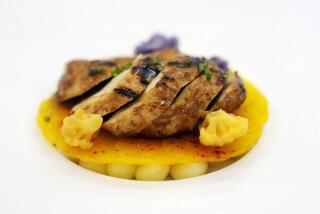A Crop of Clones Thrills Farmers, Worries Critics
- Share via
DeFOREST, Wis. — She has a case of silver trophies and blue ribbons and in almost every show she has entered, she has walked off a winner. Toronto. Hartford. Madison. Mandy is a celebrity and she seems to know it.
Her name has generated big buzz--in Holstein circles. Her pedigree is impeccable, her production of milk nearly twice that of the average cow.
So it seemed natural when her owner got the call. One Mandy was great, so how about a clone? Think of it. Those strong legs. That broad chest. That large udder that seemed welded under her belly. What about a carbon copy of this all-star bovine?
Ron Bader had grown up on a dairy farm and had raised thousands of cattle over 30 years, but he wasn’t keen on “tinkering with Mother Nature.”
A visit to Infigen Inc., a biotechnology firm in this central Wisconsin town, erased his doubts. He saw healthy-looking clones and agreed.
“As you get older, you open your mind a little,” the 69-year-old Bader says. “Years ago, this would have been a Buck Rogers-type thing. You wouldn’t expect that it would ever happen.”
But it did. Dolly proved that.
The birth of the sheep in Scotland in 1996--the first mammal cloned from an adult--was a landmark, turning the stuff of science fiction into a four-legged reality. Dolly offered a new way of reproducing and genetically modifying animals, a technology some say could save thousands of lives and generate billions of dollars.
Critics, however, say cloning is fraught with too many unknowns and potential hazards. A recent study in the journal Science reported that scientists doing cloning experiments found that even apparently normal animals develop disorders later in life.
Those reservations haven’t stopped research.
Scientists are cloning elite cows and bulls--those that produce the most milk or the most tender beef.
They’re copying pigs for organ and tissue transplants and genetically altering goats, cows and sheep to carry drugs in their milk.
They’re duplicating disease-resistant farm animals. And coming soon, they predict, cats and dogs.
“We were dreaming about this 15 years ago, but certainly it was just a dream,” says Chuck Long, general manager of Genetic Savings & Clone, a Texas-based biotechnology company with clients worldwide who have banked cells in hopes of copying their animals.
Pigs, cattle, goats, sheep and mice already have been cloned. And a team of scientists at Texas A&M; University is working on “Missyplicity,” a $3.7-million project to copy a 14-year-old dog financed by the pooch’s owners.
Cloning also is being used to make transgenic animals--those altered with extra genetic material to enhance a trait--to serve as drug “factories,” producing human proteins in their milk to fight diseases such as hemophilia and hepatitis.
But cloning is not limited to the research lab.
Last fall, Mandy appeared at an auction at the World Dairy Expo in Madison, entering the ring with the accouterments of a rock star--fog, a spotlight, the strains of music from “2001: A Space Odyssey.”
“She kind of considers herself a queen,” Bader says.
Her appearance that day was on behalf of her clone, which fetched $82,000 at the auction.
“If we get an exact clone of Mandy, it’s going to be a piece of work,” beams Spencer Landswerk, a lifelong dairyman and one of 14 members of a syndicate--including Bader--that bought the unborn clone, due this September.
At the Minnesota Zoo, Gene, a cloned bull, holds court with two cloned heifers, Carbon and Copy, all produced by Infigen.
Clones, contrary to Hollywood notions, aren’t always the spitting image of their donors. Their color and markings may differ because of environmental factors.
Proponents say cloning could someday be an enormous benefit to everyone from farmers to people with genetic diseases.
“This technology is really an incredibly powerful tool for good,” says Kevin Wells, a former Agriculture Department scientist who has worked on cloning.
But opponents argue that cloning is a way of playing God, that it allows scientists to produce animals they know could be abnormal and that it poses the danger of shrinking the genetic pool.
The recent study in the journal Science found that genes used in cloning often don’t work properly, causing abnormalities in mice--a finding that bolsters the argument against human cloning.
Also, most cloned embryos die early during gestation. Those that survive frequently have health problems such as enlarged hearts, underdeveloped lungs or immune deficiencies. Some animals have been obese.
“All of those great promises about saving mankind--first of all, I don’t believe it and I don’t believe it’s right,” said Kathy Guillermo of People for the Ethical Treatment of Animals. “We oppose using animals as test tubes with tails.”
Cloning supporters say the kinks eventually will be worked out, but for now, cloning is inefficient.
It took 277 attempts before Dolly was produced. It took 95 for Millie, a heifer at the University of Tennessee that died in June of a bacterial infection.
“If a drug for headaches worked only 2% of the time, the FDA wouldn’t approve it,” says Wells, now at PPL Therapeutics, which financed the production of Dolly. “That’s where we’re at.”
Low success means high costs: about $25,000 to $50,000 to clone an animal, up to $150,000 if there are genetic modifications, Wells says.
Most scientists predict costs will fall sharply, but some farmers still will find it a hassle, says Dr. Mark Westhusin, an associate professor at Texas A&M;’s college of veterinary medicine in charge of “Missyplicity.”
But Bishop, Infigen’s president, predicts “farmers will accept any technology that’s affordable and makes them more money.”
Researchers also say cloning could save farmers billions if disease-resistant animals were copied--which could eliminate the need for antibiotics.
Texas A&M; has produced “Bull 86 Squared” from the frozen cells of his deceased Angus donor, “Bull 86,” which was naturally resistant to brucellosis, tuberculosis and salmonellosis, all serious diseases.
How soon cloning reaches the average farmer depends partly on the federal government.
Biotech companies have been asked to keep cloned livestock out of the food chain until the National Academy of Sciences finishes a study of the technology’s safety.
But some farmers and ranchers are forging ahead.
Bob Schauf, a Wisconsin farmer, had Blackrose, his prize-winning Holstein, cloned by Infigen. There are four copies.
“Our cow was like a one-in-a-lifetime deal,” Schauf says. “Our dream would be to trot out one of the clones and have them win and bring her back.”
Ralph and Sandra Fisher already have realized their dream. Texas A&M; cloned their Brahman, Chance, who appeared in a movie and on David Letterman. The bull died before his copy was born.
But the Texas couple is elated to have his clone--Second Chance.
“We all look at him and shake our heads and hug each other and say, ‘My God, we’ve got him back!’ ” Fisher says. “I don’t think we’ll ever lose that sense of awe. It’s like you’re in a plane wreck and your wife is missing for two weeks and you get her back.”






